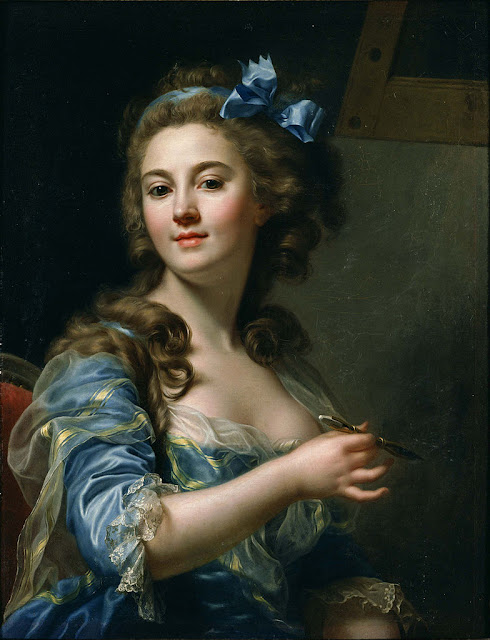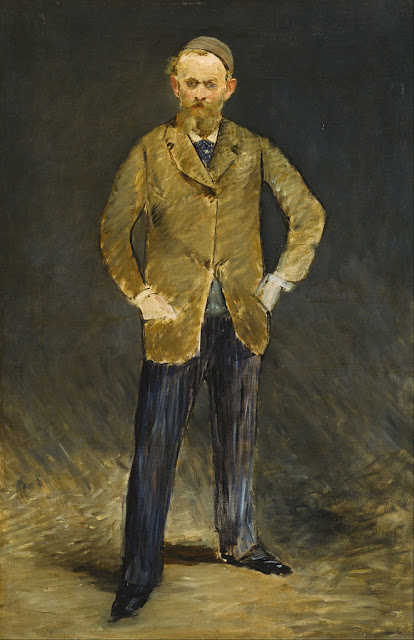 |
| Jean-Baptiste Pater Bathers before 1736 oil on canvas Bridgestone Museum of Art, Tokyo |
 |
| Paul Cézanne Bathers at rest ca. 1875-77 watercolor on paper Bridgestone Museum of Art, Tokyo |
From the Japan Weekly Mail (September 3, 1898) –
"It is probable that considerable interest will be aroused by the action of the Home Minister, Count Itagaki, in forbidding sale in Japan of Armand Silvestre's Le Nu au Salon. The peoples of the Occident have always been in the habit of sitting in solemn judgment on the peoples of the Orient in matters of morality, and it is a distinctly disagreeable slap in the face that a book allowed to be freely sold in Europe should be tabooed by the Japanese as prejudicial to moral health. For our own part, however, we have not the slightest hesitation in endorsing Count Itagaki's judgment. It is all very well to pretend, as some critics are in the habit of pretending, that the objectionable features of pictures of the nude are purely subjective. That is a remarkably clever argument. It silences cavil by constructively convicting the caviller of moral obliquity. "To the pure all things are pure. A prude who applies the epithet unclean to anything sanctioned by art merely exposes his own moral uncleanliness." Veritable despotism of discussion, that. Not one among us can frankly assert that a book like Le Nu au Salon is without demoralizing influence. Many of the pictures are beautiful, very beautiful, and a few, a very few, show the wonderful power that a really great artist possesses of subordinating the sensuous to the graceful, and suggesting the refinement of love rather than the coarseness of lust. But not a single one of them is absolutely beyond ethical criticism, and, in truth, if M. Armand Silvestre had deliberately set himself to expose the evil features of this kind of pictorial art, he could not have succeeded better than by massing together a number of drawings which, when viewed separately, might pass muster as a mere glimpse of the "naughty," but when grouped in phalanx become obtrusively shocking and demoralizing. It is not a mere question of the nude: it is a question of motives also. Many of the motives of these pictures could not be verbally described without outraging the commonest canons of propriety. The Japanese are at a parting of the ways. They have to choose the route they will adopt, and we think that Count Itagaki is choosing the right route. It will be said, no doubt, that since the reality of the nude does not shock the Japanese, they can not consistently object to its pictorial representation. An argument of that nature hardly deserves serious consideration. The Japanese have not hitherto condemned the nude under circumstances of expediency or necessity. They have not carefully secluded women's bathing places from men's – sometimes they do not separate them at all – nor have they required that a labourer in hot weather should encumber himself with garments. Unquestionably in this matter they have often allowed liberty to lapse into licence. But the principle of their procedure is purely utilitarian. There has never been any exposure of the nude for the sake of the nude. That is the fundamental difference between the sacrifice of modesty that the Japanese make to convenience, and the sacrifice of morality that Western pictures of the nude make to the sensuously attractive. In the one case the nude is seen but not looked at; in the other, it is put forward expressly to be looked at. This feature of Western art has become extravagantly prominent. Of course the general question whether the nude should be banished altogether from the atelier and the salon is outside the range of this particular discussion. We have to do with a special publication, and since it certainly is not a publication that would be permitted to circulate as an original picture album, we fail to see why its sale should be sanctioned because it is a collection of copies."
 |
| Pierre Puvis de Chavannes Fantasy 1866 oil on canvas Ohara Museum of Art, Kurashiki, Japan |
 |
| Jean-François Millet Spring (Daphnis and Chloë) 1865 oil on canvas National Museum of Western Art, Tokyo |
 |
| Claude-Joseph Vernet Summer evening landscape in Italy 1773 oil on canvas National Museum of Western Art, Tokyo |
 |
| Jean-Marc Nattier Portrait of Marie-Henriette Berthelot de Pléneuf 1739 oil on canvas National Museum of Western Art, Tokyo |
 |
| Marie-Gabrielle Capet Self-portrait ca. 1783 oil on canvas National Museum of Western Art, Tokyo |
 |
| Eugène Boudin Beach near Trouville ca. 1865 oil on panel Bridgestone Museum of Art, Tokyo |
 |
| Édouard Manet Self-portrait 1878-79 oil on canvas Bridgestone Museum of Art, Tokyo |
 |
| Gustave Moreau The Sacred Elephant 1882 watercolor, gouache National Museum of Western Art, Tokyo |
 |
| Paul Gauguin Still-life with horse's head 1886 oil on canvas Bridgestone Museum of Art, Tokyo |
 |
| Paul Cézanne Bowl and Milk-Jug ca. 1873-77 oil on canvas Bridgestone Museum of Art, Tokyo |
 |
| Edgar Degas Three dancers in red costumes 1896 pastel Ohara Museum of Art, Kurashiki, Japan |
 |
| Claude Monet Morning on the Seine 1898 oil on canvas National Museum of Western Art, Tokyo |